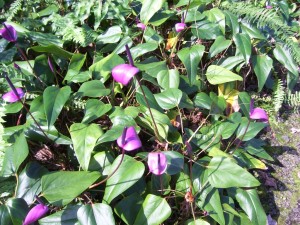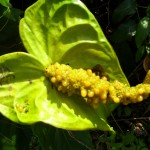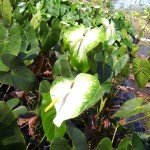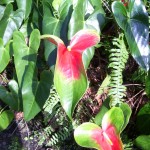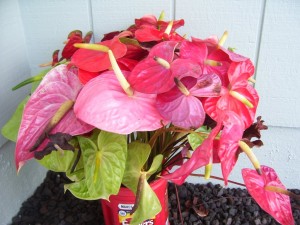Anthurium Plants: How to Keep Them Alive
Anthurium plants are vulnerable to a number of diseases, pests and poor care practices, but overall they are really easy plants to care for. In this article I am going to give you guidelines that will help you to keep your anthurium plant in excellent shape. And of course I am also going to tell you the quickest way to kill an anthurium. This one common mistake is responsible for killing more anthurium plants than all of the other mistakes combined.
The Two Keys Of Anthurium Plant Care
The two most important components of anthurium care is choosing a good location to keep your plant and watering it properly. When it comes to location, temperature, light levels and humidity are all very important aspects. With watering, both too much and too little water can cause major problems. Everything else, including fertilizing, pruning, re-potting and even pest management is secondary. To learn more about these two critical items, please review my article on anthurium care.
Light Levels: A Commonly Overlooked Factor
Light levels are critical to anthurium plants. Too much light and your plants will burn. Too little light and your plants will be stunted. The key is to strike a good balance between these two extremes. In general, you should never put your anthurium in a location that receives strong, direct sunlight. The anthurium is a rain forest dwelling plant and requires weaker, filtered sunlight. You can accomplish this by keeping your plant near a window, but out of direct sunlight or you can put a thin, gauzy curtain over your window to block out a portion of the sun’s rays.
Anthurium Pests And Diseases
When it comes to pests and diseases, you will be pleased to know that if you are only raising a few indoor plants, the majority of the pests and diseases that plague anthurium plants that are grown in a commercial setting will be of no major consequence to you. Thrips, mites, nematodes, white flies and even the deadly Xanthomonas blight should be of little concern to you.
The main disease that you have to watch out for is root rot. This is caused by a fungus that thrives in moist, warm environments. Fortunately, it is easy to prevent this disease. All you have to do is pay attention to how you water your plant. Always make sure that all excess water is allowed to drain away from the roots of your plant and make sure that you wait for the roots to dry slightly before watering again. Assuming you are using a porous potting soil, you can water daily and still meet these two conditions. You can find more detailed information in my article on anthurium pests.
The Biggest Mistake
And finally the biggest mistake you can make with an anthurium plant is very simple and easy to do. I wish that this wasn’t the case, but this one mistake is responsible for killing more anthurium plants than all the other causes combined. And it is forgetting to water your anthurium plant. In the rain forest, these plants receive water on a daily basis. Obviously rain doesn’t fall in your home, so it is up to you to water them. I believe that the best way to remember to water them is to keep them in a location where you see them everyday and just make it a habit to water them everyday at the same time of the day. And remember, if you are watering them on a daily schedule; make sure you have them planted in a potting mix that drains well to avoid root rot.
Anthurium Plant Video
This is a brief video on how to care for a potted anthurium plants. It covers potting, watering and sunlight requirements.
Other Anthurium Care Articles
- How To Fertilize An Anthurium
- How To Prune Your Anthurium Plant
- How To Create The Ideal Potting Soil For Anthuriums
Anthurium Care: How To Care For Anthurium Flowers
Proper anthurium care is easy; for the most part, you only need to address two basic factors to keep your anthurium plants healthy and you only need to avoid making three deadly mistakes to ensure that they stay alive.
The two factors that are vital for ensuring healthy anthurium plants are: the location where your keep your plant and the way in which you water your plant.
Once you have addressed these critical factors, all you have to do is avoid making the three deadly mistakes that I cover below and you will be well on your way to ensuring that your anthurium plants remain healthy.
Best Location For Anthuriums
If you want to keep your anthurium flowers healthy, you have to keep them in the right place. Anthuriums come from South American rainforests and can be harmed if they are not kept in conditions that resemble their ancestral home.
In the rain forest, anthuriums generally encounter temperatures between 70 and 90 degrees and humidity between 80 and 100%, plus they either live on the forest floor or grow on trees and so they are shaded from direct sunlight.
So, first, you have to be sure that your plant is never put in a location that freezes. Frost will kill your plant. Temperatures below 55 degrees are bad for your plant and it should ideally be kept at temperatures above 70 degrees. In addition, your plant should not be allowed to get too hot. Temperatures above 90 degrees are too hot and can also harm your plant.
Second, you have to try to ensure that your plant receives the proper amount of humidity. Humidity between 80 and 100% is ideal. But a little lower is fine as long as you water your plant regularly.
Third, you must make sure that your plant is not exposed to direct sunlight. Direct sunshine can harm its leaves and flowers. However, you do want it to receive a fair amount of light, so that it can grow well.
So, what is the best way to achieve these two conditions? The first thing you can do to ensure that your plant is kept at the proper temperature is to keep it indoors. Assuming that you keep your house between 70 to 90 degrees, your plant will find the temperature agreeable. The second thing you can do give your plant the proper humidity is keep it in the bathroom. When you take a hot shower, you will also be providing plenty of humidity for it. If you don’t want to keep your plant there and you live in a dry climate, consider keeping your plant in a room with a humidifier. Finally, keep it near a window that receives a lot of light, but make sure that it does not receive direct sunshine. If the edges of its leaves are becoming bleached or are turning brown, move it a little further away from the window to prevent them from being burnt by excessive sunlight.
Watering Anthurium Plants
Anthuriums are used to growing in tropical rain forests. The key word in the previous sentence is rain. They are used to receiving water on a daily basis. However, they are not accustomed to standing water. They typically grow on trees. So what happens is rain falls on them and it immediately drips off, it does not pool around their roots. This allows their roots to receive moisture, while also receiving exposure to air. The exposure to air is critical. This prevents the growth of anaerobic organisms that can harm them.
So the key when it comes to watering anthuriums is to water them regularly, while at the same time allowing their roots to receive air.
We can accomplish this by using a good potting soil. The ideal potting soil is light, fluffy and has to drain well. You can use just about anything as long as it meets this last criteria. Everything from sand, perlite, bark, volcanic cinder and gravel can be used to help meet this requirement.
Once you have the proper potting soil nailed down. You have to make sure that the water can drain completely out of the pot. If you have your pot in a tray, you have to make sure that you empty the tray after watering.
Do not overlook the importance of adequate drainage. The deadliest mistake of all is forgetting to water your plants, but arguably the second deadliest mistake is allowing their root system to remain soaked in water. When their roots are left in water, this prevents oxygen from reaching their roots and when this happens anaerobic microbes and fungal growth will occur and cause root rot. Left unchecked root rot will kill your plants.
Finally, we get to the actual watering of your plant. The general rule is water it everyday. As long as your pot drains completely after each watering, it is almost impossible to over-water your plant. If you have the time and live in an area with low humidity, you should also mist the leaves of your plant. Just spritz them with water twice a day.
Fertilizing Anthurium Flowers
Anthuriums need to be fertilized periodically, but you have to be careful not to over-fertilize them. This can be a deadly mistake. When fertilizing your plants, always err on the side of under-fertilizing them. If you give them too little fertilizer, the worse that will happen is that they will grow slower and produce fewer flowers, and if you see this happening you can easily fix this by giving them a little more fertilizer. But if you give them too much fertilizer they can die.
Aim to fertilize them once or twice per year depending on how long the growing season in your region lasts. Use a fertilizer with a ratio of 5-10-5 and apply roughly a quarter of what the label recommends. This ratio is ideal for ensuring a good balance between foliage and flowers. If you were to use a fertilizer with high nitrogen like, 15-10-5, you will get a bunch of leaves but fewer flowers. And when choosing a fertilizer, go for a slow release variety. This way you only have to fertilizer your plants once or twice per year, rather than once a week if you were to use a liquid fertilizer.
Conclusion
In conclusion, anthurium care is simple. Just put your plants in the proper location and water them properly. Avoid the three deadly mistakes of: forgetting to water them, over-fertilizing them and allowing water to collect around their root system; and you will have no problem keeping your anthurium plants in great shape.
Anthuriums
The genus Anthurium is a member of the family Araceae and may consist of up to 1,000 species. Since the members of this genus grow in the Amazon rainforest, which has yet to be fully explored, many new species continue to be discovered each year. Some people mistakenly believe that this genus is also native to Asia, but plants found there appear to have been introduced by humans.
Members of this genus grow in tropical rain forests that receive abundant rain fall. They can be found growing on the ground or on trees. They can grow in many forms, but the most prevalent forms are bushes or vines, attached to trees. They can grow from seeds or as offshoots of parent plants. Offshoots are genetically identical to parent plants, while seeds, even if produced by self-pollination may not be exactly identical to their parent.
All members of Araceae produce an inflorescence or spadix, where both male and female portions of the flower are present. Self pollination does not occur, unless a plant produces multiple flowers at different times because the stigma and the stamen are active at different times. The spadix is surrounded by a spathe, a modified leaf, which is mistakenly thought to be the flower by some, whereas the spadix is the true flower of the anthurium.
Anthuriums may be grown for their leaves or for their flowers. They can be grown outdoors in tropical climates or indoors in colder climates. Warmer temperatures, 65 to 80 degrees, are required, and freezing temperatures will damage these plants. They grow well in moist, but not saturated soil, with a lot of humus. Direct sunlight will harm them, so keep them in bright indirect light.
They are most commonly propagated by taking cuttings. A cutting should have at least two growing nodes that consist of bunches of roots and leaves. It should be placed in a mix of peat moss and perlite or sand and watered regularly. They may also be propagated by seed, but the production of seed will often require an expert’s skill and patience; since the process from pollination to seedling may take up to a year and a half.
Obake Anthurium Flowers
In Japanese, the word obake means “a thing that changes” and it can also be translated as “ghost”. Obake anthurium flowers (which are sometimes miss-spelled obaki) could easily have received their name from either translation. They usually come in a mix of colors, so it is easy to see that their coloration could be “a thing that changes.” In addition, they are large flowers with a wavy surface, which gives them an otherworldly or ghostly feel. Here are some of my favorite types of obake anthuriums.
Tropic Sunrise
Tropic Sunrise is a very popular orange obake anthurium. It is a large flower with an orange center, surrounded by green edges, which was developed by the University of Hawaii. H. Kanemoto created it by crossing an Anuenue with a Soga Orange Obake back in 1981.
Mauna Loa
Mauna Loa is a stunning white obake anthurium flower. It possesses a white core with a green perimeter. Mauna Loa was created from an open pollinated Tropic Ice, which means that we don’t know which variety supplied the pollen to produce this strain. In addition, it has an outstanding 56 day vase life if placed in water immediately after harvest.
Other beautiful white obake varieties include Tropic Ice, Pearl and Rainbow Obake. The Rainbow Obake is particularly beautiful, because instead of having only two colors, it has three colors. It is white in the center, has green edges and it has pink veins. Pink obake varieties include the Anuenue Obake, Kimi Obake and Watermelo Obake.
Red Obake Varieties
There are a number of red obake varieties, most have a red core surrounded by green edges. They include the Kalapana Obake, Charade Obake, Madame Pele and the Oshiro Red Obake. The Kalapana is named after a region in Hawaii that was known for having a beautiful black sand beach that was covered by a lava flow from Kilauea Volcano, which according to Hawaiian legends is the home of volcano goddess Pele, whom the Madame Pele Obake is named after.
Buying Obake Anthuriums
When you are looking to buy flowers or obake anthurium plants be prepared to pay more. These flowers are much larger and much showier than standard varieties and they are also much rarer, so naturally they are going to cost more. So if they are more expensive, don’t be alarmed. However, you will get good value for you money as these flowers look amazing and come in some very special color combinations.
If you plan on buying obake plants, just make sure you know what you are doing when it comes to anthurium care. Obake anthuriums are harder to grow than other varieties. Their large flowers and leaves make them more vulnerable to pests, diseases and the elements.
Tips For When You Buy Anthurium Flowers
When ordering anthurium flowers, there are a few things that you should know. The difference between knowing and not knowing these things can be the difference between being happy or being unhappy with your purchase.
Firstly, the number one rule is to know exactly what you are ordering. Just about all websites will show you pictures of beautiful anthurium bouquets, whether they are selling bouquets or loose flowers. But if you unknowingly order loose flowers and are expecting a bouquet you will be sorely disappointed. The key here is to read the details on what you are ordering and to ask if the description is unclear.
If you are ordering a bouquet, you can skip over the tips that follow. But if you are ordering loose anthurium flowers, read on.
If you live in a region that gets cold during the winter, be very careful when ordering at this time. Anthurium flowers are extremely sensitive to frost and can be damaged by exposure to cold temperatures when in transit. So, if at all possible, order during a warmer time of the year. Or if you simply have to order during the wintertime, choose the fastest shipping option available and request that they be shipped in an insulated box. And be sure that you are home to receive them immediately upon delivery, as they don’t take well to sitting on a freezing door step.
To get the freshest flowers and best selection, only buy when they are plentiful. Anthurium plants are most productive during the spring and summer growing seasons. If you order during these times there is often an excess supply of flowers and this will ensure that you get the best flowers. If you order during the winter, when flowers are scarce, you may end up getting leftovers. Keep in mind that winter and summer are reversed in the northern and southern hemispheres. So Costa Rica’s summer occurs during December, while Hawaii’s summer occurs during June.
Finally, when your order arrives, unpack your flowers immediately. Clip a half an inch of the bottom of their stems and place them in water right away. Clipping their stems is absolutely vital; since, your flowers will be in a dry box during transit the pores in the bottom of their stems close up as they dry out. If you were to place them in water without trimming them, they will remain closed, and not absorb water.
Celebrating Christmas in Hawaii
Like in so many other parts of the world, Christmas is a special time in Hawaii. Some aspects of Christmas are the same, like families gathering to spend time with each other and the giving of gifts. But other aspects are different due to Hawaii’s unique mix of cultures and warm climate.
The first thing you’ll notice is that Hawaii doesn’t snow at Christmas time, because the temperature seldom dips below seventy degrees, so Hawaii doesn’t have a “White Christmas.” So instead of snowball fights and sledding, families may choose to spend a sunny Hawaiian Christmas Day at the beach, wearing shorts and bikinis, and santa hats, instead of overcoats.
Christmas trees are much more expensive than in other parts of the world, because they have to be shipped across a large ocean to get here. Some families compensate by growing their own Christmas trees in their backyards. While, others substitute coconut trees or palm trees for traditional Christmas trees. But in any case they are still decorated with bright lights and ornaments.
Often families will celebrate with a luau rather and a roasted pig, rather than a Christmas Ham. The luau will be filled with tropical flowers like anthuriums, heliconias and ginger, rather than mistletoe and holly. When Santa and the Elves arrive they will often be sporting shorts and aloha shirts, instead of thick winter coats. Traditional and Hawaii Christmas carols may be sung, and they’ll often be accompanied by an ukulele instead of the more traditional instruments.
In summary, Christmas in Hawaii combines the foods and traditions of Hawaii’s numerous ethnic groups and is shaped by Hawaii’s unique climate. So don’t be surprised if you find a little bit of everything here. And remember to say “Mele Kalikimaka” which is Hawaiian for “Merry Christmas” when you are visiting.
Disclosure
This website may contain affiliate links. If you have any questions, please find my contact information in the “Contact” page of this website.
I may receive compensation for providing opinions on products, services, websites and various other topics in the form of a commission whenever a visitor clicks on an affiliate link.
Even though I may receive compensation, I always try to provide my honest opinions, findings, beliefs, or experiences here.
The view and opinions expressed in this blog are my own. Any product claim, statistic, quote or other representation about a product or service should be verified with the manufacturer, provider or party in question.
Privacy Policy
Your Privacy
Your privacy is important to us. To better protect your privacy we provide this notice explaining our online information practices and the choices you can make about the way your information is collected and used. To make this notice easy to find, we make it available on our homepage and at every point where personally identifiable information may be requested.
Google, as a third party advertisement vendor, uses cookies to serve ads on this site. The use of DART cookies by Google enables them to serve adverts to visitors that are based on their visits to this website as well as other sites on the internet.
To opt out of the DART cookies you may visit the Google ad and content network privacy policy at the following url http://www.google.com/privacy_ads.html Tracking of users through the DART cookie mechanisms are subject to Google’s own privacy policies.
Other Third Party ad servers or ad networks may also use cookies to track users activities on this website to measure advertisement effectiveness and other reasons that will be provided in their own privacy policies, Anthurium Hawaii has no access or control over these cookies that may be used by third party advertisers.
Collection of Personal InformationWhen visiting Anthurium Hawaii, the IP address used to access the site will be logged along with the dates and times of access. This information is purely used to analyze trends, administer the site, track users movement and gather broad demographic information for internal use. Most importantly, any recorded IP addresses are not linked to personally identifiable information. Links to third party Websites
We have included links on this site for your use and reference. We are not responsible for the privacy policies on these websites. You should be aware that the privacy policies of these sites may differ from our own. Changes to this Privacy Statement
The contents of this statement may be altered at any time, at our discretion.
If you have any questions regarding the privacy policy of Anthurium Hawaii then you may contact us by using our contact form

